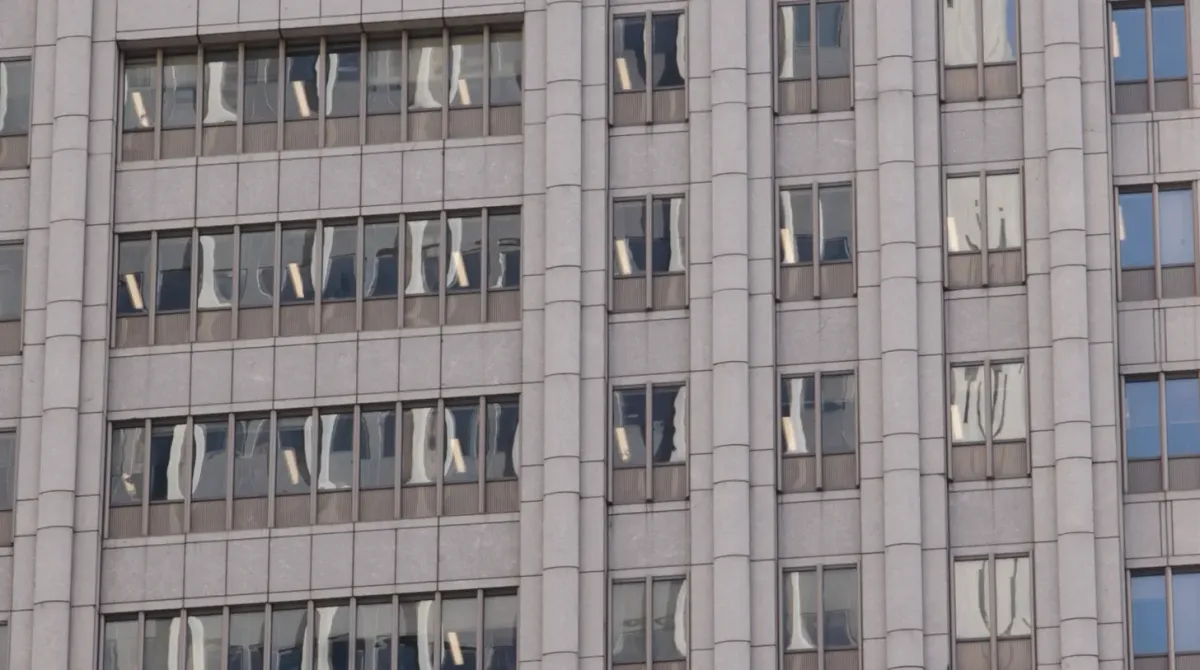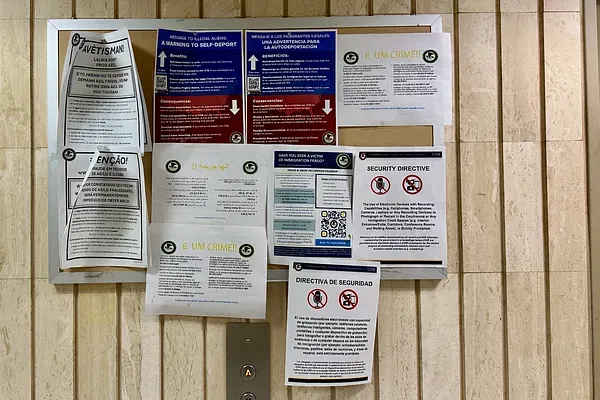Some things we saw this summer

Due Process in Tatters
Originally posted on September 15, 2025
N.S
Most of the ICE agents wear balaclavas. A few wear N95s. You can’t see any faces. Some carry guns and tasers. They all have cuffs. They have on flak vests that say POLICE. They wear no police badge or uniform.
They’re standing in a knot in the low-ceilinged, fluorescent-lit hallway. Maybe eight of them. They look at their phones. They chat about overtime and movies they’ve watched recently.
These are the people in the waiting room outside of courtroom 22: a woman with an infant, a toddler and a small child; a woman with two teenagers and one tween; a middle-aged man wearing a red polo shirt; a woman with curly hair and dangly earrings; and a heavily made-up woman who is close to tears.
They’re all waiting for family members who are inside of courtroom 22. A few volunteers make small talk with the families. This is my first time. My raggedy Spanish doesn’t flow, and I’m afraid I’ll cry if I talk too much.
Suddenly, the court room door bursts open and people stream out. I look around for guidance from more experienced volunteers. Then a voice booms out from the doorway, “This is your bathroom break! Go to the bathroom now!” And then, “You all don’t belong in here. Family only in the waiting room.” And finally, “Ma’am, you can feed your baby. Go ahead and feed your baby.”
The court clerk, wearing a cool-toned floral dress, stands at the door and repeats firmly that the court watchers need to leave. We have the right to be in the waiting room and the right to observe court proceedings, but we don't want to make waves. It could create problems for the people we’re trying to help.
We file out of the room and stand in the hallway, about ten feet from the ICE agents. I don’t want to look at them but I can’t stop staring. What kind of person takes this job?
A security guard comes by and tells us we can’t be in the hallway. We file back into the waiting room. The court clerk raises her voice again and tells us we’re not supposed to be in the waiting room. We explain that the security guard told us not to stand in the hallway.
I look at my phone. My shift is almost over. I’m not sure I want to do this again.
P.A.
Today, a dozen people were taken just from the five courtrooms operating on the floor I visited. And there are five or six other floors where immigration judges hear asylum cases. Maybe someone knows the complete tally, but I do not.
By taken, I mean that the person exited a courtroom looking relieved, almost optimistic. Then, the enforcers take them. Sometimes, a person is taken--by which I mean kidnapped--whose asylum application is still pending. That is, the judge has not agreed to close the case, has even given the applicant a new court date sometime in the future. The person might say, "But...." The discussion ends there. "Come with us," the enforcers say. They are almost gentle with women and older men, but always firm and single-minded. Or sometimes harsh, and brutely physical.
Cameras snap. Freelance photographers record each abduction. I suppose they can sell these photos or videos, or perhaps they upload them to TikTok or Insta. The photo can record the look of surprise or despair on the face of the abductee, but not what it means for them to enter a world in which they no longer have a face or an identity. A world in which they have, to borrow a term from Orwell, become an "unperson."
I do have frames of reference for such horrors. My reading about the methods of the Nazis, of Mussolini's Fascisti, or photographs of present-day Israel's crimes in Gaza. But I have never witnessed. Witnessing is different from having a frame of reference. To have a frame of reference is a privilege. Witnessing the abduction of immigrants by ICE requires stepping forward onto what Sontag called "the same map as their suffering."
A young man comes over to me and asks in Spanish, "Why did they take my brother and not me?" What would he do now? Does his brother know his phone number, in case he's able to get to a phone inside the detention facility? How to explain to him, in my rudimentary Spanish, that there is no explanation? I wish I could awaken him from this nightmare, straighten things out for him, show him that it's daylight and things make sense.
J.M.
The lawyer for the Department of Homeland Security makes an oral motion to dismiss a case. The immigrant agrees, then asks when his next court date would be. “You don’t have another court date” says the judge. “You’re done.” The immigrant walks towards the door and I put my hand on his shoulder. I try to walk him down the hall, but a mob of ICE agents jumps him, fast. There's a melee.
Dramatic scrimmages like this are horrible to witness, but there is something especially sinister about the quiet times, when one steps off of the elevator, or rounds a corner in the hallway and catches a glimpse of masked agents silently shoving a shocked, paralyzed man or woman into an elevator or a closed staircase.

S.S.
Due process is in tatters. ICE has a list of people they intend to detain, no matter what. But they make them wait and wait and wait.
The waiting room walls are bare except for a small piece of white paper on which a warning has been printed in black block letters: “NO FOOD OR DRINK IN WAITING AREA.” The barrenness itself is a warning. Not only are the waiting and waiting people expected not to feel hunger and thirst, they are being warned against harboring any other feeling, like a love of color or some beauty, even in the form of a trite picture or seasonal decoration. There is not a single electrical outlet, table, lamp or box of tissues in the entire room. Going to the restroom risks walking past ICE agents. Waiting people are warned that their bodies don’t matter, that is, their bodies are only a matter for ICE.
B.D.
Eavesdropping on ICE officers' conversations during the lulls between abductions yields little of interest. Nevertheless, I'm a product of American public schools, and when I was growing up, there was not yet a full-fledged movement to stop teaching about how wicked the Nazis were. But it was always hard to imagine the people who actually joined the Gestapo. Were they evil to a comedic degree? So malevolent as to be—or appear—almost smart? I can now report that the answer to these questions is a resounding no.
One morning, an ICE supervisor was talking about making chocolate chip pancakes. Two of her colleagues, who I’ll call "Red Bandana Face Mask Guy" and "Red Hat Glasses Guy" joined the conversation. They were excited. Red Hat Glasses Guy grew animated at the mention of chocolate chip pancakes, and noted that a good pan is key.
“I also use mine to make a bomb-ass French toast," he added.
Red Bandana Face Mask Guy, also eager to weigh in, said, “I can’t wait to get back to Fort Bragg because that's where they've got the good fucking chow."
The supervisor spoke longingly of cereal with chocolate chip cookies. “It’s the best,” she said.”
Red Hat Glasses Guy countered that he’d already found the best cereal in the world, and it was Cap'n Crunch's Cotton Candy Crunch. He elaborated, “There's a cotton candy one, and also crunch berries. Like with cotton candy. It’s Cap’n Cotton crunch with berry.”
Red Bandana Face Mask Guy: “Oh yeah?!”
Red Hat Glasses Guy: “It’s fucking fire, bro. We all just couldn’t wait for it to come out. It was very, very good. . They were hard to find. So fucking fire, bro. I ordered it online. Yeah, I would get six boxes of it at a time. I have a hundred boxes. You could get six boxes for twenty dollars. I have a hundred of them.”
An asylum seeker emerged from the courtroom, and the ICE agents paused their debate on the relative merits of various sugary cereals. Justice had to be served, another immigrant kidnapped. For America. Sugary cereals could wait—for now.
S.S.
In the restroom, I saw a woman. At first I couldn’t understand what she was trying to tell me. I thought she was trying to show me her shoes. Then I realized she wanted me to see how her legs were shaking.
“Can you see?” she kept repeating. "Can you see? My friends don’t believe me when I tell them.”
I looked down at her legs in their tailored trousers.
“Yes, I see what you mean,” I said, “Your legs are really shaking.”
Then she told me she is an immigration judge. “I don’t see how you can stand being here, so thank you," she said.
E.N.
As each hearing concluded and another asylum seeker was sent on their way, a Spanish-speaking priest stopped them, and they talked, usually for a while. Then the person continued out. As we walked with them, I found myself literally holding my breath.
About half the time, ICE let them pass and the person, intensely relieved, went down the same elevator they came up and safely exited the building. Hopefully they made it home.
But every third person or so, the agents closed in. This is horrible to witness and remains hard to recall, though I’ve been telling all my friends about it. It feels terrible, shameful, intensely demoralizing not to be able to do anything to stop it. But at the very least, we can be aware of these fascist abductions happening in our name. I want us all to have these images seared in our minds.
Later, the priest caught my eye and pointed his chin at the ICE agents in the hallway. “They’re at funeral homes too.”
“What?” I said, disoriented.
“When I go to funerals, they are waiting outside to take people as they leave," he said.
S.S.
Keep this in mind: In Germany, few people demonstrated. Nobody donated money to help those detained or their families. Nobody put together goodie bags for children. Very few people sheltered or hid Jews. The great majority of Germans turned away. Whenever they didn’t, they made a difference. In villages where people (often with the backing of a local church) resisted, more Jews survived.



